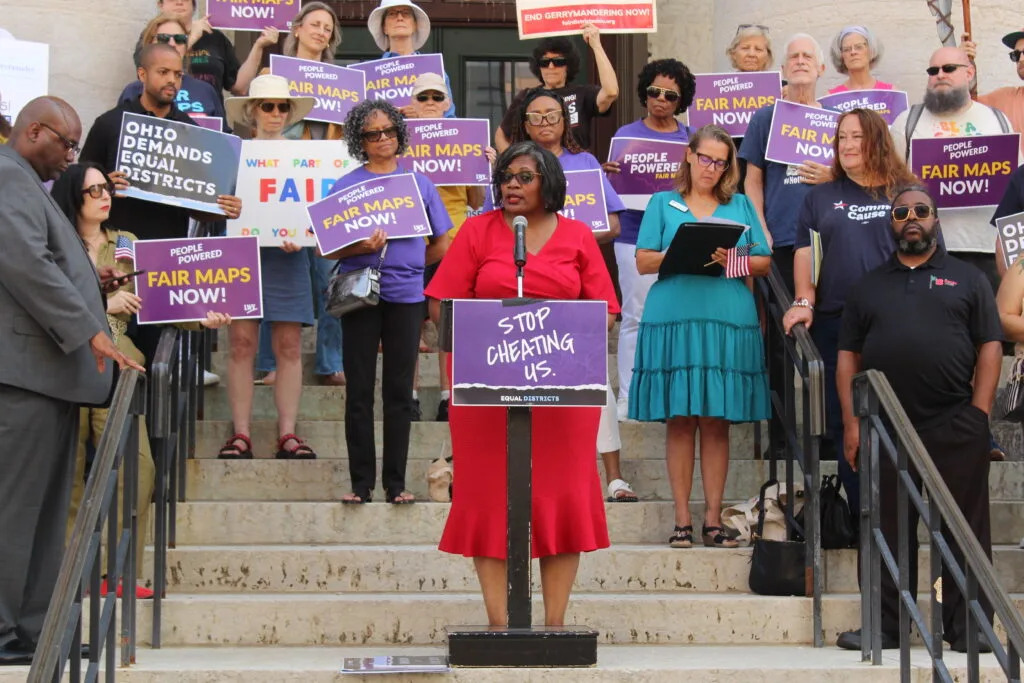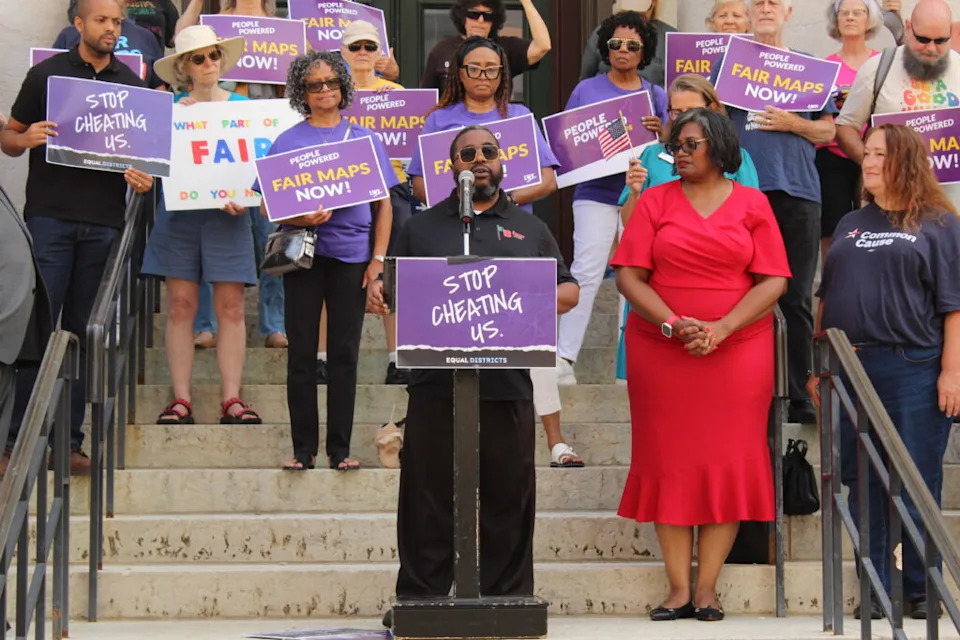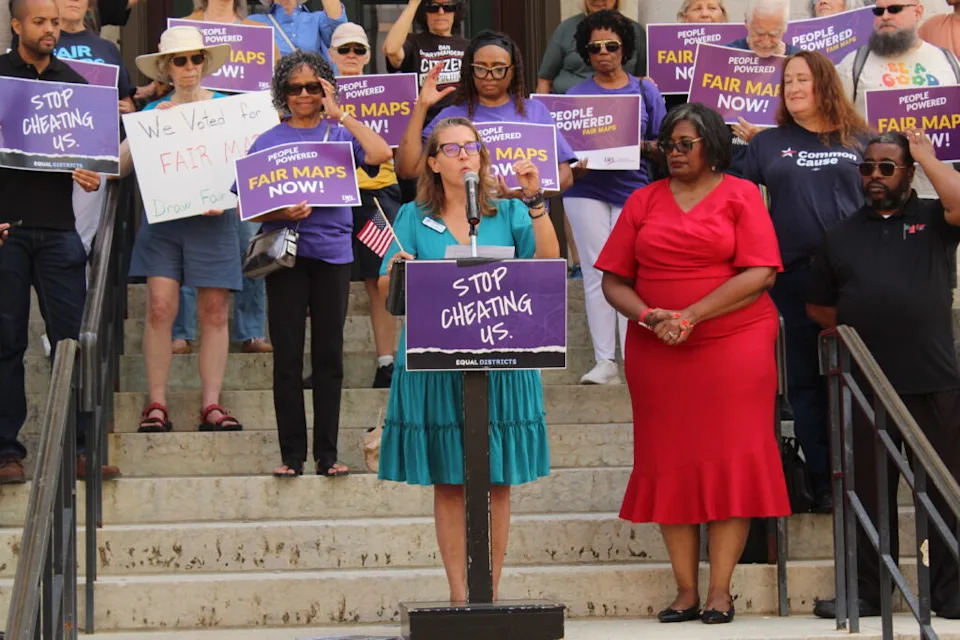
Ohio Organizing Collaborative Voter Engagement Director Deidra Reese. (Photo by Nick Evans, Ohio Capital Journal.)
Ohio lawmakers are preparing to draft new congressional districts. Several progressive organizations calling themselves the Equal Districts Coalition are joining forces again to push for fair maps.
Lawmakers are going back to the drawing board because they approved maps along partisan lines in 2021. Ohio is actually the only state in the country constitutionally mandated to do so, but the exercise comes as the Trump administration pushes Republican state leaders to redraw more maps.
The “very simple redrawing” Trump wants in Texas is an apparent bid to offset potential mid-term losses in 2026. Republicans hold an exceptionally narrow majority in the U.S. House. New, more GOP-friendly maps in a handful of Republican states might push the goalposts just far enough to stave off a Democratic majority.
With Republican gerrymandering efforts gaining momentum, some Democratic states have threatened gerrymanders of their own to negate Republican gains. But League of Women Voters of Ohio Executive Director Jen Miller was unequivocal in her opposition of those tactics.
“You can judge us by our actions as well as our words,” she said. “We have been fighting gerrymandering when the Democrats do it, and when the Republicans do it. We came out immediately and opposed (California Gov.) Gavin Newsom when he suggested that that they should gerrymander for Democrats.”
“Gerrymandering harms every voter,” Miller insisted. “We are never in support of drawing lines specifically so that politicians can win.”

What Ohio looks like
There’s little doubt Republicans have an edge in Ohio. GOP candidates regularly win statewide races by several points. But current congressional maps give Republicans a 2-to-1 advantage, holding 10 of the state’s 15 seats.
SUBSCRIBE: GET THE MORNING HEADLINES DELIVERED TO YOUR INBOX
“That is not fair. That is not representative,” Deidra Reese from the Ohio Organizing Collaborative, said.
“When I go out and I talk to people and I tell them to use their vote, I tell them it is because their vote matters,” Reese said. “But we are often facing a situation where their vote doesn’t matter because we see people who are using the power of the pen to draw maps (so) that their vote is really taken away, the power of their vote is taken away.”
And some Republicans think — with a few tweaks — they could push their advantage further. Ohio Republican U.S. Sen. Bernie Moreno suggested the party aim for 12 seats, leaving representation of Cleveland, Columbus and Cincinnati to Democrats. To get there, Republicans would target U.S. Rep. Marcy Kaptur from Toledo and Emilia Sykes from Akron — two Democrats who defended toss-up seats in the last election.
The Rev. Raymond Greene Jr. from Freedom Bloc argued his home city of Akron has been split up before, and he worries if mapmakers try to kneecap Sykes, they’ll harm the city.
“We know what happens when voices go silent,” he said. “We have been silenced for so long. Resources dry up, needs go unmet, policies are passed that benefit the few at the expense of the many. And equal districts gives us a chance to flourish together.”
How the process works
In 2018, Ohio voters overwhelmingly approved an anti-gerrymandering measure that requires buy-in from the minority party. Republicans held sway throughout the process, though, and drew maps that would benefit their candidates. The state supreme court repeatedly rejected those maps, but GOP lawmakers eventually forced them through.
Last year, Ohioans turned down an anti-gerrymandering ballot measure known as Issue 1. But Miller from the League of Women Voters noted even the measure’s opponents framed a ‘no’ vote as a vote against gerrymandering.
“Ohioans are expecting fairness,” Miller said. “We saw last year that Ohioans overwhelmingly voted to end gerrymandering, even if they didn’t understand the ballot language.”
Under the process approved in 2018, state lawmakers get the first crack at drawing a map. If lawmakers can approve a draft with 60% majorities in both chambers, and the governor signs it, that’s the map. They’ve got until the end of September.
If lawmakers can’t get there, the Ohio Redistricting Commission gets the pen. There are seven members and to approve a map they need two members from both major parties to vote yes. Five of the commission’s seven members are Republicans. They’ve got until the end of October.
If the commission deadlocks, mapmaking returns to the legislature. But this time, they only need simple majority support to approve a map. They face additional criteria like an explicit prohibition on benefiting a party or candidate and limiting community splits. They have to finish their work by November 30.

Where the rubber meets the road
In the past, Republicans have run out the clock and approved partisan maps along party lines. Organizations like the Equal Districts Coalition can challenge those maps in court, but the Ohio Supreme Court has swung sharply toward Republicans. The GOP now holds six of the court’s seven seats.
Miller said litigation is still an option, but she raised a different possibility — challenging the map at the ballot box through a referendum.
“Look, the fair districts coalition has 4,000 volunteers right now trained on signature gathering,” she said. “If there was ever a time to do a referendum, we have the infrastructure right now to collect those signatures and get on the ballot.”








Comments